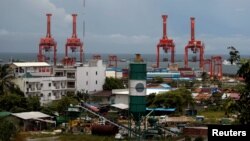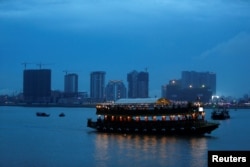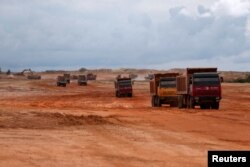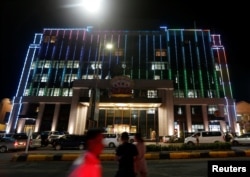The Cambodian military and government officials have denied a report claiming that a Beijing-backed development project would pave the way for a Chinese naval base in the country.
The online newspaper Asia Times reported earlier this week that the deep-water port, which is being developed by China's Union Development Group (UDG) in Koh Kong province, could host Chinese frigates and destroyers.
But Cambodia's defense department spokesman, Gen. Chhum Socheat, denied that the port would be used as a de facto Chinese naval base in the future, which would be illegal under Cambodia's constitution.
"I didn't read that report, but Cambodia's constitution says that we can't allow foreign military bases on Cambodian soil. That's the law. So what it [Asia Times] reported was a fabrication to damage Cambodia's image," he told VOA Cambodia on Friday.
China holds nearly half of Cambodia's $6 billion in foreign debt, and it is Cambodia's biggest trading partner. Chinese investments are transforming Cambodia's real estate market and gaming industry, particularly in Sihanoukville, a special economic zone.
Much of this has been driven by China's Belt and Road Initiative (BRI), which will build $1 trillion in roads, bridges, railways, ports and power plants in more than 70 countries to steer global commerce its way.
Billed as China's win-win drive for creating economic opportunity in Asia and the Indo-Pacific, the infrastructure investments, such as deep-water ports, are being met with increasing skepticism.
Some "argue that Beijing's primary goal is to accumulate political and economic leverage created by Chinese-funded projects," says a 2017 report, Harbored Ambitions: How China's Port Investment Are Strategically Reshaping the Indo-Pacific, by the C4ADS nonprofit research organization.
China's maritime BRI projects, the so-called "String of Pearls" in coastal states of the Indo-Pacific, have long been seen by many analysts as a move "to create de facto overseas military bases for China's military forces," according to the C4ADS report. While studies have found these "ports lack the infrastructure necessary to support a conventional war," the report said, "this finding does not rule out fears that China is attempting to use its commercial ports as logistical support points for long-range naval patrols defending its interests abroad."
The Cambodian port mentioned in the online report is on a concession of land, originally 36,000 hectares when it was signed over to UDG in 2008 for development of “an industrial and commercial coastal project,” according to the C4ADS report. It added that the agreement violated Article 59 of Cambodia's 2001 Land Law, which states "land concession areas shall not be more than 10,000 hectares."
The concession, which is now 45,000 hectares, includes 20 percent of Cambodia's coast, and in September, UDC board Chairman Li Tao announced plans to invest $1.2 billion to build a “Tourism City” on 1,200 hectares.
First registered as a Cambodian enterprise, by 2011, UDG was owned and operated by Chinese entities, unnamed in the report. Cambodian Prime Minister Hun Sen reimagined the enterprise in 2015, calling it a Pilot Zone project that was to include medical facilities, condominiums, resorts and hotels, manufacturing facilities, an international airport and a deep-water port.
"The Chinese see commercial ports as a foot in the door for their navy anyway. Any deep-water commercial port can be used for naval ships, so the dual purpose is always there," said Sophal Ear, associate professor of diplomacy and world affairs at Occidental College at Los Angeles, according to the Asia Times.
The article also quoted Sam Rainsy, the former Cambodian opposition leader, who said if Chinese naval vessels were allowed to use the port, it would be a violation of the 1991 peace agreement that ended Cambodia's civil war.
"By abandoning Cambodia's neutrality and being part of a possible threat against neighboring countries, Hun Sen is playing with fire," he said. "Hun Sen has not only suppressed democracy in Cambodia; he is also jeopardizing peace in our region."
However, Phay Siphan, a Cambodian government spokesman, told VOA the "small-scale" port would be used only for commercial purposes. "What is received from the Chinese investments is economic benefits to bolster economic growth, job growth and the social equity growth of Cambodia."
Soksreinith Ten of VOA's Cambodia service contributed to this report from Washington.












